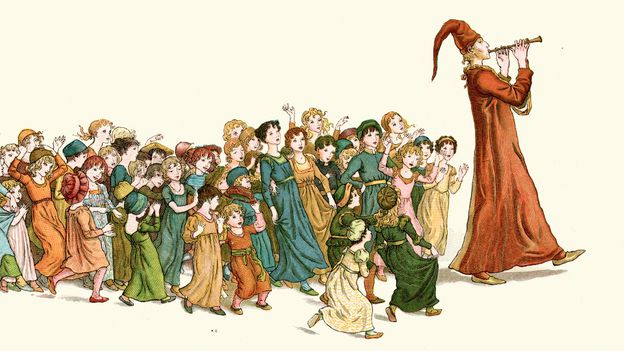The Pied Piper is a legendary tale that dates back to the early 1300s in the German town of Hamelin. The setting is believed to be related to the Hamelin church which was destroyed in 1660. This is one of the most popular German myths and legends.
The story recounts the history of the people tortured by a plague of rats that no one was able to defeat. Amid all this misery, a pied-dressed piper appeared and offered to rid the town of its infestation for a huge sum of money.
After completing his task, drowning the rats in a nearby river, the townsfolks, led by the mayor, were reluctant to honor the agreement. In revenge, the piper took all the children from the town. The town hired hunters to find the piper, in an effort to recover the children. However, the search was futile, as neither the piper nor the children, were ever seen again.
Who Wrote the Pied Piper of Hamelin?

There have been many recounts of this German tale, my favorites being:
- Robert Browning,
- Johann Wolfgang von Goethe, in the Brothers Grimm. Both writers did an excellent job in reshaping the fictional piece in short story format.
- Another account found in the Horizon Readers Book B, tells the legend from a Cuban city in Havana but goes against the historical background of the Pied Piper.
In addition, the story moves away from the common and popular fairytales, where witches use wands, spells, or potions, to get their magic done. Even the Mayor was disappointed with the extreme ease by which the piper lured the rats away from the town.
The piper placed his pipe to his lips and all the rats followed his music to a nearby river. Not one single rat stayed in the town that morning. They all drowned in the water, except for one big rat, who managed to swim to the other side of the river.
Readers will also be intrigued by the vivid descriptions used by the writers in telling this story. For example, ‘The rats were so big that they fought the dogs and killed the cats and bit the babies in their cradles.’
Even though both authors are only retelling a story, you can’t help but wonder, why the children? Why do writers use children to pay for the mistakes of the parents?
The Pied Piper highlights the deception of the piper when the mayor refuses to pay the agreed amount. So, once more, he placed his pipe to his lips, luring away all the children, except for one who was lame and unable to keep pace with the group.









I love this article. The Pied Piper of Hamelin has become a timeless piece of literature, captivating readers with its blend of folklore, morality, and the consequences of not keeping one’s promises.